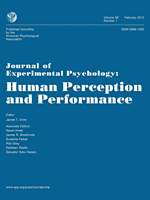
CHEMICAL SENSES
Scope & Guideline
Exploring the Intricacies of Olfaction and Gustation.
Introduction
Aims and Scopes
- Chemosensory Mechanisms:
Research into the biological and chemical processes that underlie olfactory and gustatory perception, including receptor function, neural pathways, and sensory processing. - Behavioral and Cognitive Interactions:
Exploration of how taste and smell influence behavior, memory, and decision-making processes, including the impact of sensory stimuli on emotional and social interactions. - Clinical Applications and Disorders:
Investigation of chemosensory dysfunctions in clinical populations, such as those with COVID-19, neurodegenerative diseases, and other health conditions, aiming to develop diagnostic and therapeutic strategies. - Multisensory Integration:
Studies on how olfactory and gustatory stimuli interact with other senses (like vision and touch) to shape flavor perception and influence eating behaviors. - Developmental and Evolutionary Perspectives:
Examinations of the development of chemosensory systems across species and throughout life stages, along with the evolutionary adaptations of olfactory and taste receptors.
Trending and Emerging
- Impact of COVID-19 on Chemosensory Functions:
A significant increase in research addressing the effects of COVID-19 on taste and smell, including long-term consequences and recovery strategies. - Machine Learning and AI in Sensory Research:
Growing interest in applying machine learning techniques to predict chemosensory responses and analyze sensory data, enhancing understanding of olfactory and taste mechanisms. - Neuroscience of Chemosensation:
An increasing focus on the neural correlates of taste and smell, including studies on brain connectivity, sensory processing, and the role of specific brain regions in chemosensory perception. - Personalized Nutrition and Sensory Experiences:
Research exploring individual differences in taste and smell perception and their implications for personalized dietary recommendations and interventions. - Olfactory Training and Rehabilitation:
Emerging studies on olfactory training as a therapeutic approach for individuals with chemosensory dysfunctions, aiming to enhance recovery and improve quality of life.
Declining or Waning
- Traditional Taste Research:
Research centered solely on basic taste modalities (sweet, sour, salty, bitter, umami) without integrating olfactory or multisensory perspectives is becoming less prominent. - Basic Olfactory Threshold Testing:
Studies focusing exclusively on olfactory threshold assessments without considering the broader context of odor perception and its implications for health and behavior are decreasing. - Olfactory and Gustatory Functions in Isolation:
Research that does not explore the interplay between olfactory and gustatory functions is declining, as there is a growing recognition of their interconnectedness in flavor perception. - Static Models of Sensory Processing:
Traditional, static models that do not incorporate dynamic, real-time interactions between sensory modalities are being replaced by more integrative approaches.
Similar Journals

Molecular Autism
Fostering innovation in autism research and therapy.Molecular Autism, published by BMC in the United Kingdom, is a premier open-access journal dedicated to publishing high-quality research on the molecular and genetic factors contributing to autism spectrum disorders. Since its inception in 2010, the journal has established itself as a vital resource for researchers and clinicians, offering insights into the developmental biology, neuroscience, and psychiatric dimensions of autism. With an impressive impact factor and rankings placing it in the Q1 category across multiple relevant fields such as Developmental Biology, Developmental Neuroscience, Molecular Biology, and Psychiatry and Mental Health, it serves as a critical platform for the dissemination of innovative research and interdisciplinary collaboration. The journal encourages open dialogue through its commitment to making research freely accessible, thereby advancing knowledge and fostering advances in the understanding of autism. By bridging diverse disciplines and engaging with cutting-edge research, Molecular Autism aims to enhance our understanding of autism's complexities and inform future therapeutic approaches.

Neuroscience Bulletin
Shaping the future of neuroscience and medicine.Neuroscience Bulletin is a prestigious academic journal published by SPRINGER, focusing on the dynamic and interdisciplinary field of neuroscience. Established in 2005, this journal has consistently provided a platform for groundbreaking research, showcasing contributions that span various aspects of neuroscience, physiology, and medicine. With an admirable impact factor and recognition as a Q1 journal in both Medicine and Neuroscience categories for 2023, it ranks highly in the Scopus metrics, reflecting its importance in advancing scientific knowledge and practice. Researchers and professionals alike benefit from its cutting-edge articles, which are accessible through traditional subscription models. The Neuroscience Bulletin plays a crucial role in disseminating significant findings and fostering collaboration within the global research community, making it an essential resource for anyone engaged in the exploration of neural mechanisms, treatments, and innovations.

SOMATOSENSORY AND MOTOR RESEARCH
Unraveling the Complexities of Sensory-Motor InteractionsSOMATOSENSORY AND MOTOR RESEARCH is a distinguished journal dedicated to exploring the intricate relationship between sensory and motor systems. Published by Taylor & Francis Ltd, this journal has been a significant resource for researchers in the fields of neuroscience and physiology since its inception in 1983, until it converged its coverage in 2017. Although it is no longer indexed in Scopus, SOMATOSENSORY AND MOTOR RESEARCH continues to contribute valuable insights into sensory systems and physiology, evidenced by its rankings in the lower percentiles of its respective categories. With a strong focus on empirical research, the journal aims to facilitate the dissemination of innovative studies that impact both academic understanding and clinical practices. Potential authors and researchers can access the journal's collection of past articles to further their knowledge and foster collaboration in this niche yet vital area of study. Its legacy endures as an informative platform for academics looking to bridge the gap between theoretical and applied sciences in the realm of somatosensory and motor functions.

JOURNAL OF EXPERIMENTAL PSYCHOLOGY-HUMAN PERCEPTION AND PERFORMANCE
Advancing insights into human perception and performance.JOURNAL OF EXPERIMENTAL PSYCHOLOGY: HUMAN PERCEPTION AND PERFORMANCE, published by the American Psychological Association, stands as a premier outlet for scholarly research in the fields of psychology and neuroscience. This esteemed journal, identified by its ISSN 0096-1523 and E-ISSN 1939-1277, provides an essential platform for groundbreaking studies focusing on human perception, cognitive processes, and performance. With a remarkable impact reflected in its Q1 ranking across multiple categories including Arts and Humanities, Behavioral Neuroscience, and Experimental and Cognitive Psychology, this journal maintains a prestigious position in academic discourse. Researchers and practitioners can look forward to contributing to and accessing a repository of knowledge that spans nearly five decades, with articles that adhere to the highest scientific standards. As a valuable resource without open access constraints, it invites a wide readership engaged in advancing psychological science and understanding the intricacies of human behavior.

Frontiers in Integrative Neuroscience
Connecting minds through integrative neuroscience.Frontiers in Integrative Neuroscience, published by FRONTIERS MEDIA SA, is an esteemed open-access journal dedicated to advancing our understanding of the intricate workings of the nervous system. Since its inception in 2007, this journal has become a key resource for researchers and professionals in the field, covering a wide range of topics including cellular and molecular neuroscience, cognitive neuroscience, and sensory systems. With a reputation bolstered by its open-access model, Frontiers in Integrative Neuroscience aims to promote expedient dissemination of high-quality research, ensuring that all findings are readily accessible to the scientific community and beyond. The journal has achieved a commendable recognition, ranking in the upper tiers of its respective categories according to Scopus, with a Q2 ranking in both cognitive neuroscience and sensory systems, and a Q3 ranking in cellular and molecular neuroscience. Based in Switzerland, it continues to be a pivotal platform for innovative research that shapes our understanding of neural dynamics, encouraging collaboration and knowledge exchange among scholars worldwide.

Journal of Neurophysiology
Exploring the frontiers of neurophysiological research.The Journal of Neurophysiology, published by the American Physiological Society, stands as a cornerstone in the exploration of neural function and its physiological implications since its inception in 1945. With an ISSN of 0022-3077 and an E-ISSN of 1522-1598, this esteemed journal not only holds a Q2 ranking in both the Neuroscience (miscellaneous) and Physiology categories for 2023, but also features prominently in the Scopus rankings, reflecting its significant contribution to the fields of biochemistry, genetics, molecular biology, and general neuroscience. Although the journal does not currently offer open access options, it provides peer-reviewed research that generates critical insights into the functioning of the nervous system, appealing primarily to researchers, professionals, and students eager to advance their understanding of neurophysiological processes. With its commitment to high-quality, impactful research, the Journal of Neurophysiology is a vital resource for anyone looking to stay at the forefront of neural science research.

Adaptive Human Behavior and Physiology
Unraveling the Dynamics of Human AdaptationAdaptive Human Behavior and Physiology, published by Springer Heidelberg, is a pivotal journal in the fields of behavioral neuroscience, experimental and cognitive psychology, and physiology. With its ISSN 2198-7335, this quarterly journal serves as a forum for innovative research that explores the intricate relationships between human behavior and physiological processes. Although currently categorized within the Q4 and Q3 quartiles for various psychological and physiological domains, this journal has rapidly established itself as a significant resource for cutting-edge studies from 2015 to 2024. The journal’s commitment to high-quality research is reflected in its Scopus rankings, positioning it among noteworthy publications, particularly in experimental psychology and neuroscience. This journal is vital for researchers, professionals, and students seeking to deepen their understanding of adaptive behaviors and the underlying physiological mechanisms. Join the discourse and contribute to this evolving field through your scholarship in Adaptive Human Behavior and Physiology.

Language Cognition and Neuroscience
Innovative Insights into Language Processing and CognitionLanguage Cognition and Neuroscience is a premier peer-reviewed journal published by ROUTLEDGE JOURNALS, TAYLOR & FRANCIS LTD, focusing on the intersection of linguistics, cognitive psychology, and neuroscience. Since its inception in 2013, this journal has established itself as a vital resource for researchers and scholars, contributing significantly to the understanding of how language is processed and represented in the brain. With its impressive rankings in various categories—Q1 in Linguistics and Language, Q2 in Cognitive Neuroscience, and Experimental and Cognitive Psychology—it caters to a diverse and interdisciplinary audience. The journal is accessible to readers worldwide, effectively communicating cutting-edge research and innovative methodologies in the field. Open Access options enable broader disseminations of knowledge, ensuring that significant findings reach both academic and practical applications. With a commitment to high-quality research, Language Cognition and Neuroscience continues to be an influential platform for advancing theories and practices within cognitive science and language studies.

I-Perception
Illuminating the Science of How We PerceiveI-Perception is a leading open-access journal published by SAGE Publications Ltd, specializing in the intricate interplay between perceptual processes across various disciplines such as Artificial Intelligence, Experimental and Cognitive Psychology, Ophthalmology, and Sensory Systems. With an ISSN of 2041-6695, this UK-based journal has been a vital resource since its inception in 2010. I-Perception occupies esteemed positions within several academic categories, including a Q2 ranking in Ophthalmology and Q3 rankings in both Artificial Intelligence and Experimental and Cognitive Psychology. These metrics highlight the journal’s relevance and impact, particularly in fostering interdisciplinary collaborations among researchers and practitioners. Accessible online, I-Perception encourages the dissemination of innovative findings and theoretical advancements, making it an essential platform for those passionate about understanding perception in its myriad forms. The journal's commitment to excellence is further reflected in its Scopus rankings, showcasing its influence within the respective realms of Medicine, Neuroscience, and Computer Science.

Neuroscience of Consciousness
Unlocking the Mysteries of Consciousness through Rigorous InquiryNeuroscience of Consciousness, published by Oxford University Press, stands at the forefront of interdisciplinary research in the realms of clinical psychology, experimental and cognitive psychology, neurology, and psychiatry. Since its inception as an Open Access journal in 2015, it has garnered a prestigious reputation, consistently ranking in the Q1 category across multiple fields, including a remarkable 15th rank in Experimental and Cognitive Psychology and 44th in Neurology. This journal serves as a vital resource for researchers, professionals, and students aiming to explore the complexities of consciousness through the lens of neuroscience. By providing a platform for original research, reviews, and critical analyses, Neuroscience of Consciousness enables the dissemination of innovative ideas and findings that contribute to the advancement of knowledge in this crucial area of study. Its open access model ensures that groundbreaking research is readily available to a global audience, further solidifying its impact in the academic community.